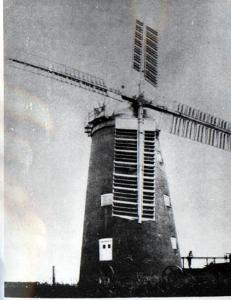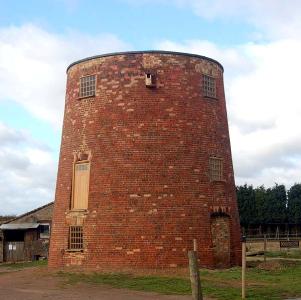Potton Windmill

Potton Windmill, 1931 [ref: Z50/91/60]
This photograph of the mill was taken in 1931 and shows some damage from a storm in January 1928 - it was taken as part of a survey of windmills in the county carried out by Bedfordshire Historical Record Society [BHRS].
BHRS Volume 14, published in 1931 included a section on the history of Bedfordshire windmills by J. Steele Elliott. He began his piece on Potton by writing about an inquisition after the death of Edmund Peverel in 1331: "The jurors say that Edmund Peverel had £14 14s. yearly rent of free tenants, a windmill which is worth 40s. by the year ... held from John de Claveryngge by service of half a knight's fee". Windmills were introduced into England around the last quarter of the 12th century.
The next date mentioned in the article is 1774 when an inclosure award of the western part of the parish [ref: MA80/2] includes Windmill Field, the inclosure does not include a mill but the 19th century windmill stood (and still stands) in this field.No mill is shown on a map of Bedfordshire of 1765 by Thomas Jeffreys and so, Steele Elliott concluded the mill must have been built between 1765 and 1774 [see below].
The earliest mention of the mill in any document at Bedfordshire & Luton Archives & Records Service is in 1808 when Thomas Waters of Wrestlingworth sold it, together with two lots of ground, for £400 to James Ingle of Potton, miller [ref: X534/1]. Ingle mortgaged the mill and ground to Sarah Munn in 1812 for £400 [ref: X534/1] and in 1818 conveyed 5 acres of arable to her in Windmill Field, the deed noting that the mill itself was to be conveyed to Thomas Mortlock and Frederick Cheetham Mortlock of Cambridge, bankers [ref: X534/1].
The deeds to the land in Windmill Field mention a conveyance in 1774 from William Hankin of Potton to Charles Franklin of Potton, surgeon [ref: X534/3], and a feoffment of 1801 from Franklin to James Brewer and Edmund Bumberry immediately followed by a mortgage to Henry Smith of Potton, cornfactor ref: [ref: X534/3], before Brewer made a feoffment to Thomas Waters in 1807 [ref: X534/3]. It is not clear whether the land included the windmill but there is a reasonable chance that it did.
Steele Elliott in his BHRS volume states that on maps of 1826 the mill is shown in its current position, a mile west-north-west of the church. He goes on: "This tower mill stands 55 feet in height to the ball terminal, and has an outer crown platform.
Three more stray deeds in another collection take the story a bit further. In 1833 the mill was owned by Jael Ingle of Cambridge, spinster, who sold it to John Smith of Potton, miller and then immediately lent him £200 on security of it, an acre of land attached to it and a further 2.75 acres allotted to James Ingle at Inclosure [ref: LS176-177]. The mill is then described as "corn windmill and roundhouse, barn and other buildings, running and going gears, sails, stones, cloths, rigging, wheels, wire machines and dressing machines" and recites that it was formerly occupied by James Ingle, then John Ingle, deceased, now John Smith. In 1833 Jael Ingle agreed to sell it to John Smith for £510 [ref: LS178].
The final mention of the mill in a document at Bedfordshire & Luton Archives & Records Service is in 1849. John Smith had taken out a mortgage for £500 with John Cressy Lloyd of Potton, partly secured on the mill in 1841 and now, eight years later, Lloyd was demanding repayment from Smith's heir following Smith's death [ref: X744/77].
In January 1853 the windmill was advertised in the Bedfordshire Times as: "First Rate Tower Windmill - All that remarkably well-built and nearly new freehold Tower windmill, with two pair of French stones, Six sails and fantail, in full trade". The six sails were blown off in a storm in 1879 and replaced by four.
In his 1983 Bedfordshire County Council published book, Bedfordshire Mills, Hugh Howes states: "The six single-sided sails were blown off in 1879 and were replaced by four double-sided patent sails. The shaft could be driven by steam especially in calm weather. The mill, which was five floors high, was connected to a granary by an iron catwalk at first-floor level. The stones were two pairs of Burr, one of Peak stone and one of Emery composition. Other machines in the mill were an Oat Crusher on the third floor, and a wire machine and scourer on the second floor".
Steele Elliott concludes his article on the windmill thus: "It last worked in 1928; on January 6th of that year the sails got athwart the wind and the fan was blown off during that well-remembered gale, and the mill has since been derelict ... The whips of the sails now alone remain. They have an overall width of about 60 feet. The sail shaft is of iron, and hollow for shutter control. The single iron casting of the sail socket and arms is said to weigh over 3 tons. The brake-wheel is 8 feet 3 inches in diameter, and entirely of wood; but the spur-wheel is of iron with wooden cogs affixed. There are five floors, and it ran the unusual number of four pairs of stones, these being placed on the three centre floors; two pairs were French Buhrs, one pair Derby Peak, and the others composite. Steam power was added to this mill in its later years of activity. The mill is connected up to the store barn some twenty yards distant by means of a wooden gangway erected at the height of the first floor of the mill. This property is now in the ownership of the Seward Trustees; some of the tenant millers were George Gurney, who was there in 1891; followed by John Gray until 1900, when the present tenant, Stephen Webb, took over the tenancy".

Potton Windmill, March 2007